Yoga For Hot Flashes: It CAN Provide Relief
By Ashley Nowe
Published:

Are you waking up with hot flashes and night sweats? Suddenly stifling in a meeting, even though to everyone else the room feels quite cool? Ugh!
Menopausal hot flashes can last a moment or two, or even as long as an hour. They occur because your body is having trouble regulating its temperature. This is due, in part, to the loss of estrogen that occurs in perimenopause.
Maybe you feel like you’ve tried everything for relief, but have you tried yoga for hot flashes?
No matter what stage of life you’re in, yoga offers many benefits. Practicing yoga can aid in stress relief, lower anxiety, increase flexibility and muscle tone. And, believe it or not, it can help relieve some of the symptoms specific to perimenopause, like hot flashes.
Yoga for Hot Flash Relief
Let’s get into how yoga can help manage hot flashes and other peri symptoms. Anecdotally, many women share that yoga is an effective treatment for vasomotor symptoms (aka hot flushes or those sudden, uncomfortable heat sensations).
Officially, studies show “yoga significantly improved menopausal symptoms and sleep quality in peri- and post-menopausal women.”
Another study showed even one hour of yoga twice weekly “may reduce the psychological, somatic, and urogenital symptoms experienced in menopause.”
So, How Does Yoga Relieve Hot Flashes?
Yoga’s combined focus on movement, meditation, and breathing techniques help to promote physical and mental well-being. Certain types of yoga, like restorative, yin, or hatha, have shown to be particularly effective for treating hot flashes.
During perimenopause, your nervous system is in flux (as are just about all of your body’s other systems). Your hormone levels are constantly shifting. Yoga – especially restorative poses – helps to soothe and calm your nervous system.
Mindfully and slowly moving through movements reduces stress and anxiety. This, in turn, triggers fewer and less intense hot flashes.
Stress hormones, such as cortisol, can also trigger hot flashes. Breathwork, called pranayama in yoga, helps lower cortisol and provide an overall feeling of calm. Breathing exercises with a focus on cooling not only promote relaxation, but also help regulate body temperature. Therefore, focusing on breathwork can also ease and reduce hot flashes.
Yoga for Menopause
Next time you feel overheated, or the anxiety takes over, give yoga a try. It doesn’t need to be a long, daily practice. You don’t need a ton of space or fancy equipment.
And it is totally safe to do if you’re new to yoga, or aren’t particularly flexible. Always listen to your body and make sure to breathe!
Supportive forward folds, gentle inversions, and restorative poses can help cool the body and ease the nervous system. Try working through a couple of poses or taking a few moments to complete a breathing exercise. This may provide some initial relief. Practicing regularly, over time, will enhance the benefits.
Cooling Yoga Poses Hot Flashes
Our expert yoga instructor, Gina Brogna Homes, explains that there are several poses and breathwork (called pranayama) techniques that help bring cooling and water energy to the body.
If you’re in the middle of a hot flash or are prone to the symptom, give these poses a try. They are done slowly so as not to build heat in the body and help with chest opening and expansion, which can provide relief for those uncomfortable vasomotor symptoms.
- While many of the poses are broken down below, you can also follow along with Gina as she leads this flow designed to relieve hot flashes.
Goddess Pose
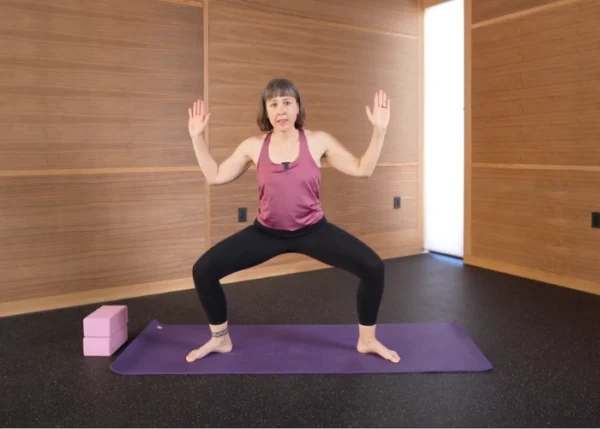
This pose strengthens legs, hips, and core, while opening and expanding the chest and shoulders.
- Start by standing (mountain pose), and step your feet wide, about three feet apart with toes pointed slightly outward.
- Lower into a squat, keeping knees tracking over your toes
- Raise your arms out to shoulder height and bend your elbows to about 90 degrees, palms facing forward.
- Engaging your core, hold the pose as you breathe slowly in and out.
Triangle Pose
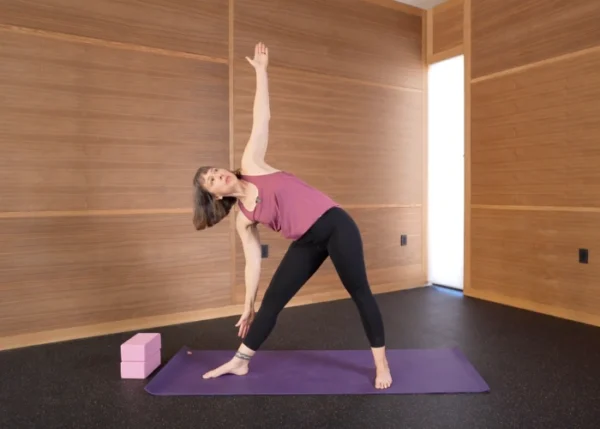
Also called Trikonasana, triangle pose stretches the legs and hips while encouraging the chest and shoulders to open.
- Begin in a standing position, with feet about 3 – 4 feet apart. Turn your front foot out 90 degrees (think toes pointing forward to the short end of a mat), and back foot straight, or parallel with the long edge.
- Hinge at your hips, reaching your right arm down toward your right foot. Extend your left arm up toward the ceiling.
- Keep your spine long and chest open. Look up, down or straight ahead – whatever is most comfortable for your neck.
- Add in a yoga block under your right hand for support. Breathe in and out slowly.
- Repeat on the other side.
Pyramid Pose
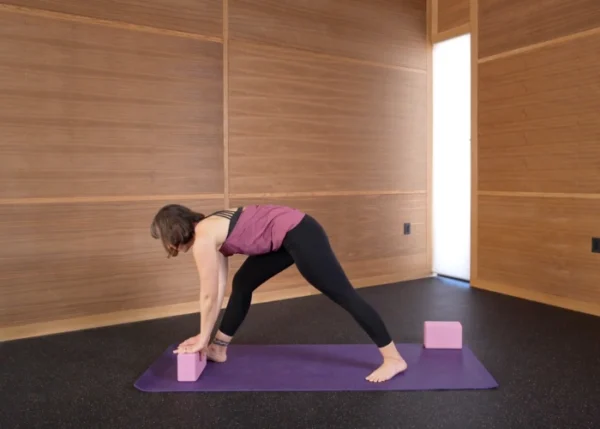
This forward fold helps lengthen the spine and hamstrings. Because your head is lower than your heart, it can also provide hot flash relief. Bending forward can help lower your heart rate and blood pressure.
- Begin in a standing (mountain) position. Step one foot back about 3 feet, keeping your legs parallel, like train tracks. Note: Turn out the back leg slightly if you’re feeling pressure on your back knee or hip.
- Check your form: keep your hips nice and square, facing the front. Engage your legs.
- Hinge forward from your hips, folding over your front leg with a long, flat spine.
- Rest your hands on the ground or blocks on either side of your front foot.
- Inhale and exhale slowly, allowing your body to relax into this pose.
- Repeat on the other side.
Crescent Lunge
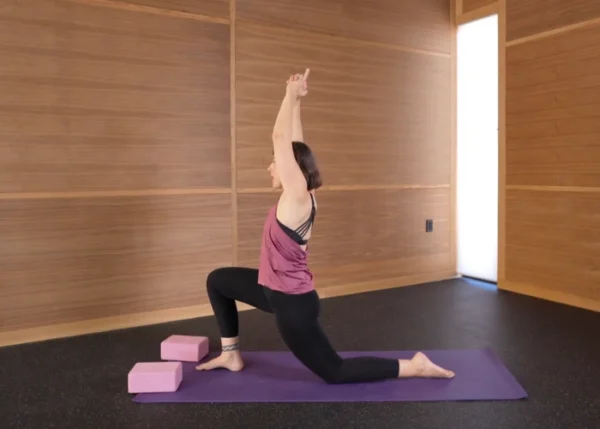
This is a yoga backbend, and encourages the opening of the chest and heart. It’s also a good pose to help with balance and stability, and helps strengthen your legs and core.
- Start from pyramid pose or from downward dog. Gently rest your left knee on the ground and untuck the toes. Your right foot stays on the ground with your leg bent in a 90 degree position.
- Lift both arms above your head, in line with your ears, palms facing each other.
- Inhale and exhale slowly, thinking of the quality of water as you do so, to help with cooling effects.
- Repeat on the other side.
Wide-Legged Forward Fold
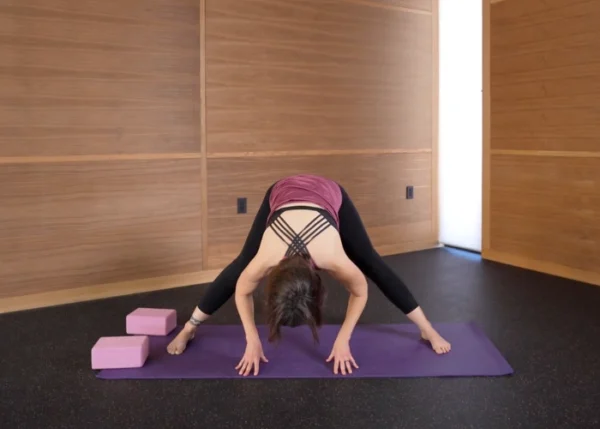
This pose stretches hamstrings and inner thighs, and stretching directly impacts the nervous system. Bending forward with your head lower than your heart is called an inversion. Inversions are great for perimenopause because they trigger your body to lower heart rates, blood pressure, and mental activity.
- Stand with legs a few feet apart, feet parallel to each other.
- Slowly bend forward at the hip, keeping your spine long and straight.
- Hold onto your ankles and keep your neck long, balancing your weight across your feet.
- If you want to, use a yoga block to support your head, making the post even more restorative.
- Breathe in and out slowly, relaxing your shoulders and allowing your chest to open.
Breathwork for Perimenopause Symptoms
While the breath is a major component to yoga poses and flows, you can also do breathwork on its own. Below are a few techniques that have been shown to have cooling effects “in the moment.” They help calm the nervous system, and therefore ease or prevent hot flashes.
Gina also shared some of her favorite cooling breathwork techniques:
Cooling Breath
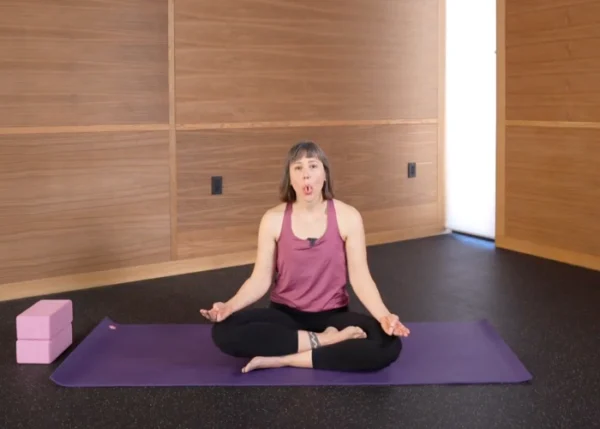
The cooling breath, or “sheetali pranayama”, may help lower your body temperature.
- Sit or lie down comfortably. Rest your palms in your lap to help them keep cool.
- Now curl your tongue (think “taco tongue”) and keep it that way as you slowly inhale through your mouth. Exhale through your nose.
- Repeat for one to five minutes, taking a break if needed.
- Note: If you can’t curl your tongue, that’s ok. Open your mouth slightly to allow your tongue to “float” between your teeth and inhale through your mouth this way.
Box Breathing
Sometimes called “sama vritti,” or square breathing, this technique involves inhaling and exhaling for the same length of time.
- Sit or lie down in a comfortable position, keeping your spine nice and long. Close your eyes and focus on your breath.
- Inhale through your nose for four counts. Hold the breath for four counts, then exhale gently through your mouth for four counts. Pause for four counts and then begin again.
- Repeat the “box” breath 5 – 10 times.
A few notes:
- Find a gentle yoga class: Seek out classes that focus on restorative poses and/or yin yoga. The Menovation app offers a range of yoga classes you can do from anywhere, on your schedule.
- Listen to your body: ALWAYS listen to your body. If something hurts, follow instructor modifications. As with all workouts, you want to push yourself, not hurt yourself.
Other Benefits of Yoga During Perimenopause and Menopause
Yoga is a great way to find relief from vasomotor symptoms in perimenopause. As touched on above, it also has countless other benefits that can help improve your overall well-being and quality of life. Yoga has been shown to:
- Reduce stress and calm the nervous system
- Relieve muscle and joint aches
- Provide more mental clarity
- Improve sleep quality
- Help balance mood and emotions
- Strengthen muscles and bone density
- Improve balance and joint mobility
While yoga can’t magically stop hot flashes, it is yet another tool in our perimenopause toolkit. If hot flashes are causing major disruptions to your life, or are accompanied by other symptoms, please talk with your health provider.
How Menovation Can Help
We are here at Menovation to help support and empower you through your perimenopause sleep issues and beyond. It features exercises, nutrition plans, and education for improved well-being, reduced symptoms, and inspiring self-care for confidence and vitality. Then tell a friend – we are trying to keep the lines of communication about perimenopause open, right?
As always, talk to a doctor or mental health professional about your experience. Be sure to reach out to a professional for additional support, especially if you are experiencing severe symptoms, want to explore hormone therapy, or have other health concerns.
Take the “What stage am I in?” quiz here to find out what stage of perimenopause or menopause you are in and receive a free guide to help you feel your best during that time!
Ready to feel stronger through perimenopause? The Menovation app is your go-to hub for perimenopause fitness, health tips, and support. Available now in the App Store and Google Play. Start free trial here.